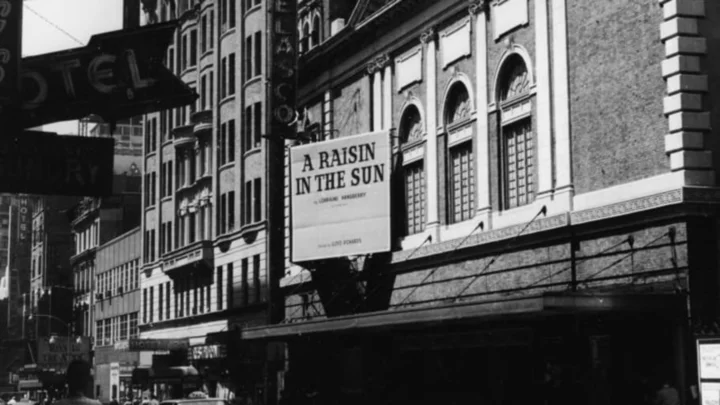James Baldwin defied categorization. His first novel, Go Tell It on the Mountain, was partly
based on his adolescence in Harlem in the 1930s and branded him as a promising writer of Black fiction—a label he quickly eschewed. For his next novel, Giovanni’s Room, he drew from his experience as a gay man to explore homosexuality and masculinity through the perspective of white characters.
The book follows David, an American man, who heads to Paris to sort himself out prior to his marriage to his fiancée Hella. There, he meets and develops a sexual relationship with Giovanni, a waiter at a gay bar. When Hella comes to Paris, and Giovanni is accused of murdering the bar’s owner, David must negotiate his feelings for Hella and Giovanni, as well as his bisexual identity.
Race and sexuality—and the relationship between the two—were topics Baldwin revisited throughout his career as a writer and activist. Thirty-five years after his death, Giovanni’s Room remains one of the best-known works of his prolific career. Here are nine facts about the 1956 novel. (Note: If you haven’t read the novel, there are spoilers below!)
More from Our Site
- •
An International History of Dumplings
•100 Weird, Miscellaneous Facts
•15 Incredible Books by Stonewall Book Award Winners
•13 Audiobooks You Didn’t Know Were Narrated by Celebrities
1. James Baldwin was inspired by his time in Paris.
Readers familiar with Baldwin’s biography will recognize details from the writer’s life in
Giovanni’s Room. After growing up in New York City, Baldwin moved to the French capital at
age 24. France is where he spent most of his life and wrote some of his most influential
works.
Baldwin’s life in Paris was a major source of inspiration for Giovanni’s Room. As a gay
man in the 1950s, he was also able to pull from his own experiences when crafting the book’s
gay relationships. But while he borrowed elements from real life, Baldwin emphasized that the
book wasn’t autobiographical. He later explained, “it is more of a study of how it might have
been or how I feel it might have been. I mean, for example, some of the people I have met. We
all met in a bar, there was a blond French guy sitting at a table, he bought us drinks. And, two or
three days later, I saw his face in the headlines of a Paris paper. He had been arrested and was
later guillotined. That stuck in my mind.”
Baldwin’s novel ends with Giovanni being guillotined for murdering the owner of the bar
where he worked.
2. Giovanni’s Room followed a dark period in Baldwin’s life.
When Baldwin moved to France in 1948, he was looking for an escape. “My luck was running out,” he told The Paris Review years later. “I was going to go to jail, I was going to kill somebody or be killed. My best friend had [died by] suicide two years earlier.” He characterized moving to Paris as a matter of survival. “I didn’t know what was going to happen to me in France, but I knew what was going to happen to me in New York. If I had stayed there, I would have gone under, like my friend.” Rather than leaving the darkness he experienced back home, Baldwin used his time abroad to explore uncomforable themes in his work, including Giovanni's Room.
3. Baldwin intentionally steered away from racial themes.
Baldwin’s first novel, Go Tell It on the Mountain, dealt heavily with racial injustice. For his
second novel, the author decided to write strictly about white characters. He believed that racism and homophobia are connected, but when writing Giovanni’s Room, he wasn’t ready to tackle
both issues at once. “I certainly could not possibly have—not at that point in my life—handled
the other great weight, the ‘Negro problem,’” he said in a 1980 interview. “The sexual-moral
light was a hard thing to deal with. I could not handle both propositions in the same book. There
was no room for it.”
4. The book features an American perspective.
Giovanni's Room features white characters living in Paris, but Baldwin still managed to explore his home country through the eyes of his American expatriate narrator. On his time working in France, the author said, “Once you find yourself in another civilization, you’re forced to examine your own.”
This can be observed near the end of the novel, when David’s girlfriend highlights the fragility of the white American experience. “Americans should never come to Europe, it means they can never be happy again,” Hella says. “What’s the good of an American who isn’t happy? Happiness was all we had.”
Baldwin’s stint spent examining his birthplace from afar ended shortly after the novel’s publication. In 1957, he returned to the United States to participate in the Civil Rights Movement and toured the country giving lectures on racial inequality.
5. Baldwin used different working titles.
The perfect name for his novel didn’t come to Baldwin right away. It went by the working titles One for My Baby (which came from a song penned by Harold Arlen and Johnny Mercer) and A Fable for Our Children during the drafting process. He eventually settled on the title Giovanni's Room, spotlighting the story’s tragic love interest.
6. His publishers told him to burn Giovanni’s Room.
The book’s subject matter was such a shock to Baldwin’s publishers at Knopf that they wanted
him to burn the manuscript. The fact that it dealt with topics that were taboo at the time wasn’t
the only problem; because Giovanni’s Room was so different from Go Tell It on the Mountain,
his publisher feared Baldwin would alienate his reader base. Knopf refused to move forward with the book.
7. One editor was fine with the subject matter, but didn’t like the novel.
Knopf book editor Henry Carlisle rejected Baldwin’s novel, but not because he found the gay love story offensive. He wrote in a brutal letter to the author, “All of us are convinced that this novel confirms your talent as a writer … Our objection is not to the length or the subject of the book; we simply felt strongly that you are not successful in what you are trying to do. … we think that publishing this book, not because of its subject but because of its failure, will set the wrong kind of cachet on your writing and estrange many of your readers.”
8. The publisher hid Baldwin’s author photo.
Even after receiving harsh rejections from publishing industry professionals, Baldwin didn’t give up on finding a home for his novel. It was ultimately published by Dial Press in the U.S. in 1956. The new publisher wasn’t totally supportive, however: They shared many of Knopf’s fears and pulled Baldwin’s author photo, supposedly to hide the fact that a novel about queer white characters was written by a Black man.
9. Giovanni’s Room was well received following publication.
Despite the hand-wringing surrounding its release, Giovanni’s Room received a generally positive response. Baldwin had already proven himself as a literary heavyweight with his debut novel Go Tell It on The Mountain, and critics were willing to give him the benefit of the doubt as he explored a new direction. In its original review, The Atlantic said the book “belongs in the top rank of fiction.”
10. Giovanni’s Room is still relevant today.
Giovanni's Room came out before the gay liberation movement, and decades later readers are returning to the text. The 2020 novel Swimming in the Dark follows two gay lovers living in Poland under communism. Author Tomasz Jedrowski cited Giovanni’s Room as a major inspiration, and even includes the novel as part of the plot. Regarding the book, Jedrowski told Interview magazine, “[It spoke] to me like a book never had before, like a kindred spirit who had gone through what I had gone through.”
Critical appraisal of the novel has also grown in the years since its publication. The title has appeared on lists of the best gay and lesbian novels, as well as the most influential works of fiction of all time.
Related Tags
History AUTHOR HOME WRITING FACTS BOOKS LISTS DEATH WORK EUROPE Home / BOOKS








